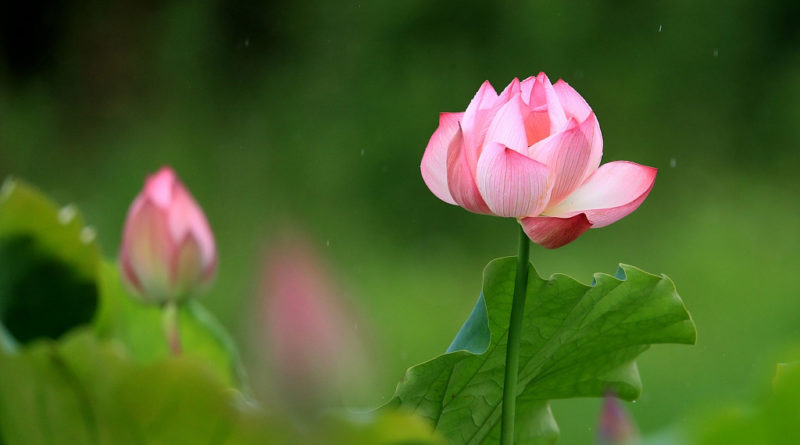A Modern Introduction To The Buddha’s Teaching – Chapter 5: The Role Of Meditation – Dr Victor A. Gunasekara
CHAPTER 5: The Role of Meditation
We have seen that the Buddhist path consists of wisdom/knowledge, ethical conduct, and mental development. Some teachers put an almost exclusive emphasis on the last of these (calling it “meditation”) as the route to the other two. Because of the widespread propagation of this view in the West it is worth considering it in some detail(16) .
The widely held picture of meditation in the West is one where the meditator sits in silent company, usually in the “lotus position”, and is engaged in inward contemplation. The session may last from a half-hour to several hours. It is generally a congregational activity but it is usually presided over by a teacher who determines the duration of the session and may give directions as to how the activity is to proceed. Practitioners are encouraged to engage in the activity individually at home if congregational meditation is not possible. Often special meditation retreats are held lasting from 3 to 14 days in which up to 12 hours a day may be devoted to meditation activities. Because of the long periods involved sitting meditation is alternated with “walking meditation”, sometimes also with yogic exercises. Often silence is enforced during the retreat (called the Rule of Golden Silence), and the teacher has individual meetings with each participant during which the individual practitioner’s “progress” is probed and special instructions given. The teacher is very often looked upon as a “guru” as in the Hindu tradition. This type of meditative exercise is often represented as the exclusive way to “practice” Buddhism. We shall use the term “stylised meditation”(17) to designate this kind of meditation.
Meditation on the other hand has always been a valid part of Buddhist practice (note however that is a part, nor the whole of it). The task is then to differentiate genuine Buddhist meditation from stylised meditation. Buddhist mediation is the practice of the last two components of the eightfold path (sati and samadhi) in the “right”(samma) manner. The Pali term that is used to denote stylised meditation is bhavana. This term is not used with great frequency in the Pali Canon and when used is associated with mental development from whatever kind of activity that will improve the mind.
Stylised meditation is derived from meditation practices in the principal Asian Theravada countries, viz. Sri Lanka, Burma and Thailand each of which has developed their own meditation traditions. In spite of the diversity within each country a few broad generalisation may be possible. In Sri Lanka the primary focus of Buddhist practice has been on the cultivation and in the development of ethical practice (sala). Meditation has not occupied great prominence and has been undertaken on an individual basis, rarely performed in a congregational setting. In this the Sri Lankan Buddhists have generally followed the instructions on meditation given in the Visuddhimagga of Buddhaghosa which was composed in that country. Where meditation has been used as the principal focus in Sri Lanka it has been practised by reclusive forest monks with little contact with the rest of the Bhikkhu-sangha or the laity. The country from where stylised meditation was introduced into the West is Thailand. Here the “forest” orders have enjoyed much more status than elsewhere. They tend to look on stylised meditation as the key to the entire Buddhist practice including the achievement of wisdom and morality. This system attaches much importance to the jhanas which is considered almost indispensable to enlightenment. There is little attempt at sutta-study except those relating to meditation. While this kind of meditation may suit the lifestyle of forest monks it is their importation into the general community, especially of lay persons, that is questionable. If the Sri Lankan and Thai modes of meditation can be taken as occupying two ends of a spectrum the meditation practice of Burma occupies an intermediate position. Here meditation is taken more seriously than in the Sri Lankan tradition but some of the excesses of the Thai forest tradition are avoided(18) .
Buddhist meditation of whatever type takes two principal forms – the cultivation of calm and tranquillity (samatha bhavana) and the cultivation of insight (vipassana bhavana). The efficacy of meditation in promoting calm and tranquillity is indisputable. In fact it is for this reason that it is also adopted by some non-Buddhist schemes such as Hinduism and “transcendental meditation”. But its use as a method of achieving insight into reality it may be questioned. True insight comes only we understand that the three signata underlie all phenomena. In meditation one may come to the realise this within in the ambit of ones own experience, but it will not lead one understand the universality of these traits. Thus meditation has to be supplemented by other methods such as the first two components of the Buddhist path.
The classic discourse on which the theory of meditation is based is the Satipahana Sutta, which occurs twice in the Canon. Here the Buddha identifies four methods (or foundations) of meditation. These are the contemplation of the body (kayanupassana), of feeling (vedananupassana), of the mind (cittanupassana) and finally that of the dhammas (dhammanupassana). Some preconditions are laid down in the Sutta before these contemplations are attempted. One is that the practitioner should have “overcome in this world covetousness and discontent” (vineyya loke abhijja domanassa). In the case of lay persons this does not require complete withdrawal from the world, but the development of a sufficient degree of detachment from it. The Satipahana cannot be attempted by those completely given to greed. The second is that the contemplations should be done in an empty room or if outdoors at the root of a tree. This rules out the congregational sessions in which stylised meditation takes place.
The contemplation of the body, with the initial focus on the breath, is the initial contemplation that is taught by most teachers. The Buddha used it purely as the starting point of his sequence of contemplations, and he even recommends the “lotus position” in which to undertake the contemplations, which is a classic yogic stance. The Buddha extended the traditional Vedic meditation concerns by extending the contemplation to other physical postures and awareness of other bodily actions, and finally to the contemplation of the foulness of the body. The progress of the meditation from the body to feelings is also relatively easy for many practitioners. The next stage of the contemplation of the mind is relatively more difficult. The objective here is to achieve one-pointedness of mind. This is relatively difficult because of the propensity of the mind to shift quite fast.
The last one requires contemplation of the Dhammas. In the Buddha’s time when the corpus of dhamma was memorised, this contemplation was the only way of acquiring the knowledge of the dhamma. Today the situation is somewhat different and this particular foundation of mindfulness could be acquired by discursive study.
The view that the awakening of wisdom can only come through intense meditation is not only found in schools like Zen but is also held by some teachers of Theravada(19) . However meditation in Buddhism is primarily a method of mental training. It could be used to calm the mind, to instil tranquillity, and to set the stage for the realisation of true insight. In fact fascination with meditation can be a distraction from the true path. A capable exponent of early Buddhism David Maurice puts this quite well: “There is meditation at the very beginning of the practice but the practice is to get away from meditation” (20) .
Even though stylised meditation may not be necessary it is necessarily harmful. It could suit the temperament of some people, especially those who desire a strict discipline. On the other hand what we have termed Buddhist meditation is something that anyone can do with profit. It may not lead to the final goal in itself, but it could be a great help in the fulfilment of the other components of the path.








